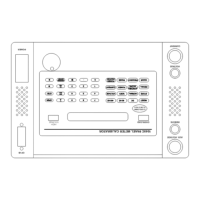15
Calibration Mode
The stored calibration constants can only be modified while in the calibrate mode. The
calibrate mode is identified by a circle with a cross character appearing in the right-hand
position of the display, usually after the units designator. While in the calibrate mode any
or all of the stored constants may be modified. There are two methods of exiting the
calibrate mode. If STORED is pressed, all of the modified calibration constants will be
stored in non-volatile memory for use during regular operation. If RESET is pressed, the
modified calibration constants will be discarded and the PMC will revert to normal
operation using the previously stored constants.
PMC operation in the Calibrate Mode differs from normal operation. Only five output
amplitude levels are available for each range. These are 1/10, 1/4, 1/2, 3/4 and top of
range. Once in the desired range, the CLEAR key cycles the output through these five
values. Also, only 60 and 400 HZ frequencies and 30° phases are available.
Calibration Constants
There is one calibration constant for the bottom and one for the top of each range. When
the output is at 1/10 of range, the bottom constant may be modified. The top of range
constant may be modified only while the output is set to top of range. No adjustments can
be made at the 1/4, 1/2, or 3/4 settings.
Make modifications by entering a number on the keypad and pressing ENTER. During
amplitude alignment the output will change approximately .01% times the number entered.
For phase the factor is 0.1°. A long settling time should be allowed (10 seconds or more)
after each adjustment is made.
NOTE: the two calibration constants for each range affect each other. A +0.1%
change at the top of range will produce a 0.1% change at the bottom of range . A
+1.0% change at the bottom of range will produce a +0.1% change at the top of
range.
After aligning the top and bottom of ranges, recheck both outputs to find any interaction in
the alignments.

